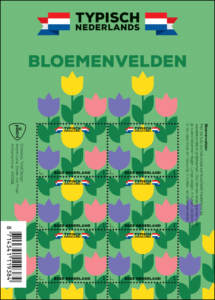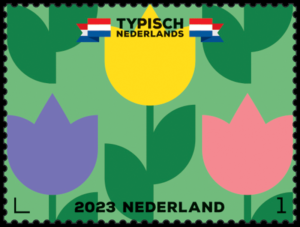[from PostNL’s press release] [click on any of the pictures for larger versions]
Typically Dutch – Flower Fields
Date of issue: 20 March 2023
Appearance: sheet of six stamps in six identical designs
Item number: 430361
Design: Adam Lane and Edwin van Praet, Total Design, Amsterdam
On 20 March 2023, PostNL will publish the Typically Dutch – Flower Fields stamp sheet. This issue is the third in the Typically Dutch series this year. The multi-annual series started in 2020 and, in 2023, will be dedicated to a variety of sights and attractions that are  significant for and typical of the Netherlands. The six identical postage stamps will be marked ‘Nederland 1’, the denomination for items weighing up to 20g destined for the Netherlands. A sheet of ten stamps costs €6.06. The Typically Dutch – Flower Fields issue was designed by senior graphic designer Adam Lane and creative director Edwin van Praet from Total Design in Amsterdam. As part of this stamp series, stamps featuring museums (2 January) and mills (13 February) were published earlier this year. Stamps featuring cheese markets (15 May) and the wadden mud flats (14 August) will follow later this year.
significant for and typical of the Netherlands. The six identical postage stamps will be marked ‘Nederland 1’, the denomination for items weighing up to 20g destined for the Netherlands. A sheet of ten stamps costs €6.06. The Typically Dutch – Flower Fields issue was designed by senior graphic designer Adam Lane and creative director Edwin van Praet from Total Design in Amsterdam. As part of this stamp series, stamps featuring museums (2 January) and mills (13 February) were published earlier this year. Stamps featuring cheese markets (15 May) and the wadden mud flats (14 August) will follow later this year.
The first flower fields were created between Leiden and Haarlem on geest lands at around 1850. Geest land soil consists of sand mixed with clay or peat, a type of soil that proved very suitable for growing flower bulbs. Such bulb fields can also be found elsewhere in the Netherlands, including in northern Noord-Holland, near Venlo, on Texel, in north-western Friesland, in the Noordoost Polder and on the Zeeland and Zuid-Holland islands. The flowering of the fields annually attracts around 2 million tourists. After the crocuses in February, tulips, daffodils and hyacinths bloom from March to May. In late summer, gladioli, dahlias, carnations and asters take over for the next colourful period.
Flowers may be lovely, but really, cultivation is all about the bulbs themselves multiplying underground.
The floriculture of flowers and plants is an important economic sector in our country, with an export value of €7.3 billion in 2021. The Netherlands also plays an important role in the  trade of flowers grown elsewhere. 52 percent of the world trade in cut flowers, both home grown and imported from other countries, passes through Dutch hands. The FloraHolland cooperation is the world’s largest flower auction, handling over 90 per cent of Dutch trade. The history of Dutch flower culture dates back to the 16th century, when the tulip first arrived in the Netherlands. The famous flower originated in the Ottoman Empire (present-day Turkey) and was first planted by Carolus Clusius in the hortus botanicus in Leiden. Its name, tulip, also comes from the East. Ottoman sultans wore the flower on their turban – dūlbend in Persian – which is what the word tulip is derived from, meaning white tulip.
trade of flowers grown elsewhere. 52 percent of the world trade in cut flowers, both home grown and imported from other countries, passes through Dutch hands. The FloraHolland cooperation is the world’s largest flower auction, handling over 90 per cent of Dutch trade. The history of Dutch flower culture dates back to the 16th century, when the tulip first arrived in the Netherlands. The famous flower originated in the Ottoman Empire (present-day Turkey) and was first planted by Carolus Clusius in the hortus botanicus in Leiden. Its name, tulip, also comes from the East. Ottoman sultans wore the flower on their turban – dūlbend in Persian – which is what the word tulip is derived from, meaning white tulip.
Design: The Typically Dutch – Flower Fields stamp sheet features colourful illustrations of stylised tulips. Each stamp features three tulips side by side. The stem and leaves of the tulip on the left and right continue on the stamp below. The iconic shapes of the tulips are grouped in a tight pattern across the stamps. The pattern is interrupted on the sheet edge.  The background of the stamp sheet and stamps is a soft shade of green. The other colours match the background: purple, yellow and pink for the tulips’ flowers, dark green for the stem and leaves. Along the bottom of each stamp runs a white strip containing the sorting hook, the year 2023, the country (Nederland) and the denomination (1). The logo for the Typically Dutch series is printed above each stamp, with a folded Dutch banner on the left and right. The Typically Dutch logo appears once more on the top edge of the sheet, while the right edge features a short explanatory text. The title of this issue on flower fields in the Netherlands is printed in dark green on the sheet border between the large pictorial logo at the top of the stamp sheet and the stamps.
The background of the stamp sheet and stamps is a soft shade of green. The other colours match the background: purple, yellow and pink for the tulips’ flowers, dark green for the stem and leaves. Along the bottom of each stamp runs a white strip containing the sorting hook, the year 2023, the country (Nederland) and the denomination (1). The logo for the Typically Dutch series is printed above each stamp, with a folded Dutch banner on the left and right. The Typically Dutch logo appears once more on the top edge of the sheet, while the right edge features a short explanatory text. The title of this issue on flower fields in the Netherlands is printed in dark green on the sheet border between the large pictorial logo at the top of the stamp sheet and the stamps.
The choice of the tulip as the flower on the stamps of Typically Dutch – Flower Fields was pretty obvious, stamp designer Edwin van Praet believes. ‘It is a typically Dutch flower. In  fact, you won’t find a flower that’s more Dutch than the tulip. Moreover, it is pretty easy to turn the tulip into an iconic shape. Tulips are at their most beautiful when you see them outside together. I often travel along the geest lands by rail, from The Hague to Amsterdam and back. In spring, you can admire the flower fields with their gorgeous colours through the train window. You really get the best views from the train.’
fact, you won’t find a flower that’s more Dutch than the tulip. Moreover, it is pretty easy to turn the tulip into an iconic shape. Tulips are at their most beautiful when you see them outside together. I often travel along the geest lands by rail, from The Hague to Amsterdam and back. In spring, you can admire the flower fields with their gorgeous colours through the train window. You really get the best views from the train.’
The other stamp designer, Adam Lane, has also got to know the Dutch flower fields. ‘I cycled there once, from Amsterdam to Lisse. In England, where I come from, flowers are a lot less important than they are here. And when you see flowers in England, they usually come from the Netherlands. For the design of the flower field stamps, I used the simplest geometric tulip shape. It is the art of leaving things out – the balance between slightly too much and too little detail. When you put multiple tulip shapes in a pattern, they become easily recognisable. It also helps that the colours remind you of a bouquet. Or rather, of a field full of flowers.’
The Typically Dutch – tulips stamps are available while stocks last at the post office counter in Bruna shops and through the webshop. The stamps can also be ordered by phone from the Collect Club customer service on telephone number +31 (0)88 868 99 00. The validity period is indefinite.
Technical Details:
Stamp size: 40 x 30mm:
Sheet size: 122 x 170mm
Paper: normal with phosphor print
Gum: gummed
Printing technique: offset
Printing colours: cyan, magenta, yellow and black
Print run: 75,000 sheets
Appearance: sheet of 6 stamps in 6 identical designs
Design: Adam Lane and Edwin van Praet, Total Design, Amsterdam
Printer: Cartor Security Printers, Meaucé-La Loupe, France
Item number: 430361



